Dong Hye Ye
Unified Cross-Modal Attention-Mixer Based Structural-Functional Connectomics Fusion for Neuropsychiatric Disorder Diagnosis
May 21, 2025Abstract:Gaining insights into the structural and functional mechanisms of the brain has been a longstanding focus in neuroscience research, particularly in the context of understanding and treating neuropsychiatric disorders such as Schizophrenia (SZ). Nevertheless, most of the traditional multimodal deep learning approaches fail to fully leverage the complementary characteristics of structural and functional connectomics data to enhance diagnostic performance. To address this issue, we proposed ConneX, a multimodal fusion method that integrates cross-attention mechanism and multilayer perceptron (MLP)-Mixer for refined feature fusion. Modality-specific backbone graph neural networks (GNNs) were firstly employed to obtain feature representation for each modality. A unified cross-modal attention network was then introduced to fuse these embeddings by capturing intra- and inter-modal interactions, while MLP-Mixer layers refined global and local features, leveraging higher-order dependencies for end-to-end classification with a multi-head joint loss. Extensive evaluations demonstrated improved performance on two distinct clinical datasets, highlighting the robustness of our proposed framework.
Physics-Guided Multi-View Graph Neural Network for Schizophrenia Classification via Structural-Functional Coupling
May 21, 2025Abstract:Clinical studies reveal disruptions in brain structural connectivity (SC) and functional connectivity (FC) in neuropsychiatric disorders such as schizophrenia (SZ). Traditional approaches might rely solely on SC due to limited functional data availability, hindering comprehension of cognitive and behavioral impairments in individuals with SZ by neglecting the intricate SC-FC interrelationship. To tackle the challenge, we propose a novel physics-guided deep learning framework that leverages a neural oscillation model to describe the dynamics of a collection of interconnected neural oscillators, which operate via nerve fibers dispersed across the brain's structure. Our proposed framework utilizes SC to simultaneously generate FC by learning SC-FC coupling from a system dynamics perspective. Additionally, it employs a novel multi-view graph neural network (GNN) with a joint loss to perform correlation-based SC-FC fusion and classification of individuals with SZ. Experiments conducted on a clinical dataset exhibited improved performance, demonstrating the robustness of our proposed approach.
Breast Cancer Classification in Deep Ultraviolet Fluorescence Images Using a Patch-Level Vision Transformer Framework
May 12, 2025Abstract:Breast-conserving surgery (BCS) aims to completely remove malignant lesions while maximizing healthy tissue preservation. Intraoperative margin assessment is essential to achieve a balance between thorough cancer resection and tissue conservation. A deep ultraviolet fluorescence scanning microscope (DUV-FSM) enables rapid acquisition of whole surface images (WSIs) for excised tissue, providing contrast between malignant and normal tissues. However, breast cancer classification with DUV WSIs is challenged by high resolutions and complex histopathological features. This study introduces a DUV WSI classification framework using a patch-level vision transformer (ViT) model, capturing local and global features. Grad-CAM++ saliency weighting highlights relevant spatial regions, enhances result interpretability, and improves diagnostic accuracy for benign and malignant tissue classification. A comprehensive 5-fold cross-validation demonstrates the proposed approach significantly outperforms conventional deep learning methods, achieving a classification accuracy of 98.33%.
Dynamic Contextual Attention Network: Transforming Spatial Representations into Adaptive Insights for Endoscopic Polyp Diagnosis
Apr 28, 2025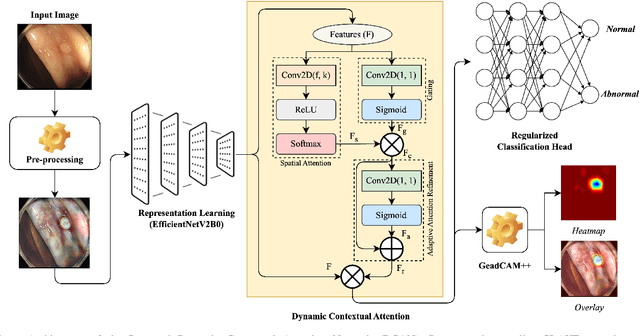

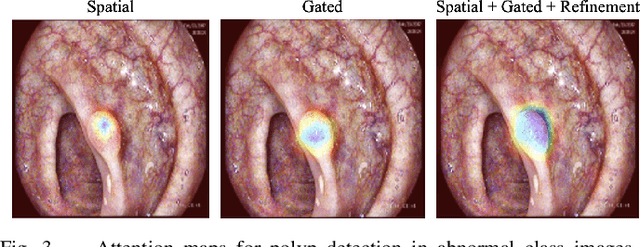

Abstract:Colorectal polyps are key indicators for early detection of colorectal cancer. However, traditional endoscopic imaging often struggles with accurate polyp localization and lacks comprehensive contextual awareness, which can limit the explainability of diagnoses. To address these issues, we propose the Dynamic Contextual Attention Network (DCAN). This novel approach transforms spatial representations into adaptive contextual insights, using an attention mechanism that enhances focus on critical polyp regions without explicit localization modules. By integrating contextual awareness into the classification process, DCAN improves decision interpretability and overall diagnostic performance. This advancement in imaging could lead to more reliable colorectal cancer detection, enabling better patient outcomes.
GCS-M3VLT: Guided Context Self-Attention based Multi-modal Medical Vision Language Transformer for Retinal Image Captioning
Dec 23, 2024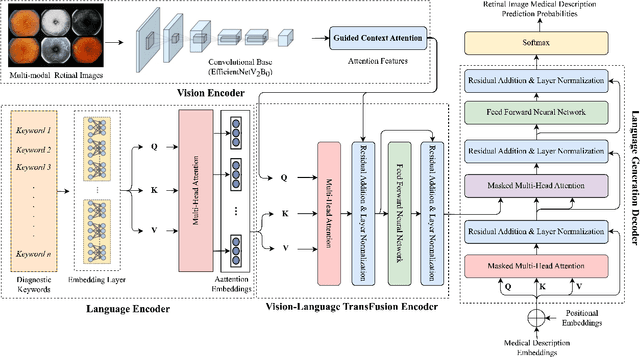
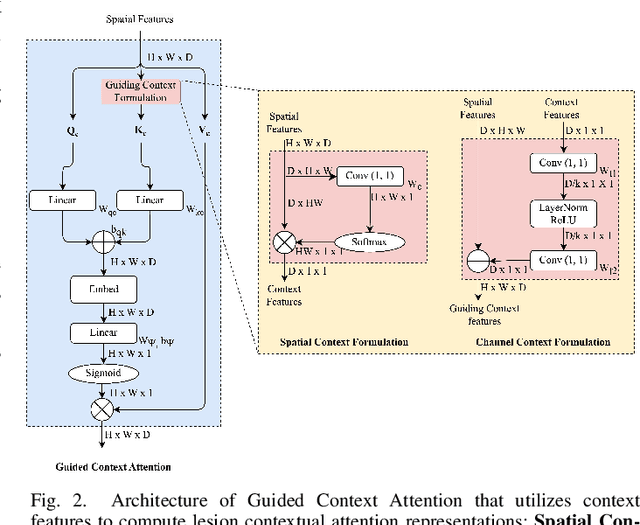
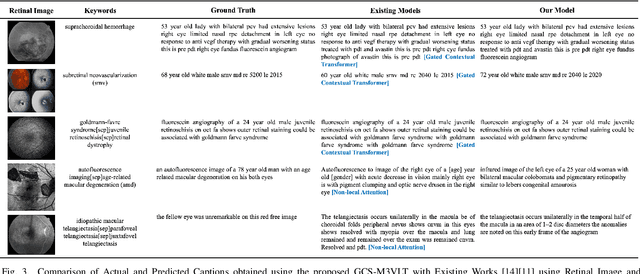
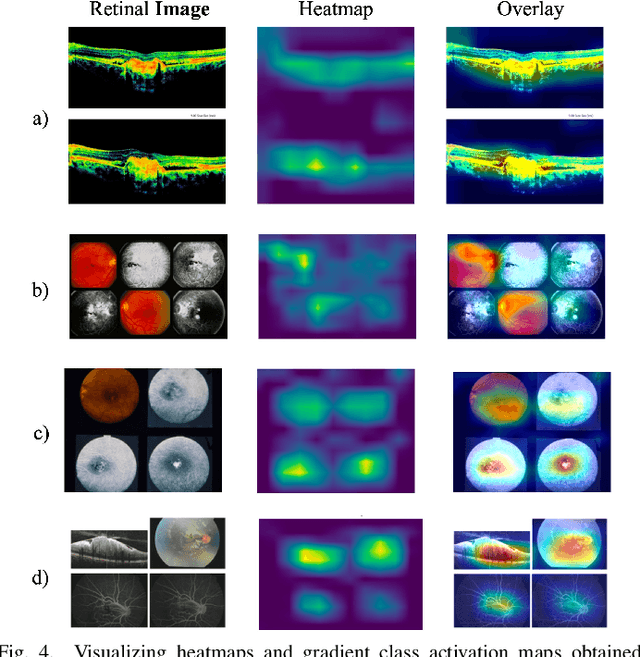
Abstract:Retinal image analysis is crucial for diagnosing and treating eye diseases, yet generating accurate medical reports from images remains challenging due to variability in image quality and pathology, especially with limited labeled data. Previous Transformer-based models struggled to integrate visual and textual information under limited supervision. In response, we propose a novel vision-language model for retinal image captioning that combines visual and textual features through a guided context self-attention mechanism. This approach captures both intricate details and the global clinical context, even in data-scarce scenarios. Extensive experiments on the DeepEyeNet dataset demonstrate a 0.023 BLEU@4 improvement, along with significant qualitative advancements, highlighting the effectiveness of our model in generating comprehensive medical captions.
Multi-modal Imaging Genomics Transformer: Attentive Integration of Imaging with Genomic Biomarkers for Schizophrenia Classification
Jul 28, 2024


Abstract:Schizophrenia (SZ) is a severe brain disorder marked by diverse cognitive impairments, abnormalities in brain structure, function, and genetic factors. Its complex symptoms and overlap with other psychiatric conditions challenge traditional diagnostic methods, necessitating advanced systems to improve precision. Existing research studies have mostly focused on imaging data, such as structural and functional MRI, for SZ diagnosis. There has been less focus on the integration of genomic features despite their potential in identifying heritable SZ traits. In this study, we introduce a Multi-modal Imaging Genomics Transformer (MIGTrans), that attentively integrates genomics with structural and functional imaging data to capture SZ-related neuroanatomical and connectome abnormalities. MIGTrans demonstrated improved SZ classification performance with an accuracy of 86.05% (+/- 0.02), offering clear interpretations and identifying significant genomic locations and brain morphological/connectivity patterns associated with SZ.
Deep learning for automated detection of breast cancer in deep ultraviolet fluorescence images with diffusion probabilistic model
Jul 01, 2024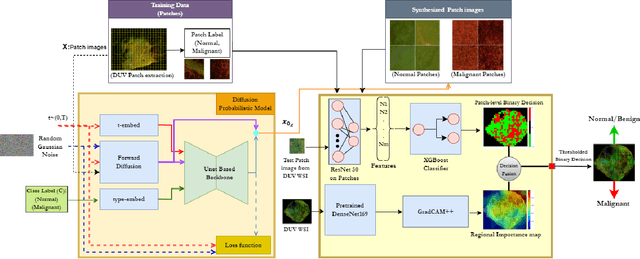


Abstract:Data limitation is a significant challenge in applying deep learning to medical images. Recently, the diffusion probabilistic model (DPM) has shown the potential to generate high-quality images by converting Gaussian random noise into realistic images. In this paper, we apply the DPM to augment the deep ultraviolet fluorescence (DUV) image dataset with an aim to improve breast cancer classification for intraoperative margin assessment. For classification, we divide the whole surface DUV image into small patches and extract convolutional features for each patch by utilizing the pre-trained ResNet. Then, we feed them into an XGBoost classifier for patch-level decisions and then fuse them with a regional importance map computed by Grad-CAM++ for whole surface-level prediction. Our experimental results show that augmenting the training dataset with the DPM significantly improves breast cancer detection performance in DUV images, increasing accuracy from 93% to 97%, compared to using Affine transformations and ProGAN.
Guided Context Gating: Learning to leverage salient lesions in retinal fundus images
Jun 19, 2024Abstract:Effectively representing medical images, especially retinal images, presents a considerable challenge due to variations in appearance, size, and contextual information of pathological signs called lesions. Precise discrimination of these lesions is crucial for diagnosing vision-threatening issues such as diabetic retinopathy. While visual attention-based neural networks have been introduced to learn spatial context and channel correlations from retinal images, they often fall short in capturing localized lesion context. Addressing this limitation, we propose a novel attention mechanism called Guided Context Gating, an unique approach that integrates Context Formulation, Channel Correlation, and Guided Gating to learn global context, spatial correlations, and localized lesion context. Our qualitative evaluation against existing attention mechanisms emphasize the superiority of Guided Context Gating in terms of explainability. Notably, experiments on the Zenodo-DR-7 dataset reveal a substantial 2.63% accuracy boost over advanced attention mechanisms & an impressive 6.53% improvement over the state-of-the-art Vision Transformer for assessing the severity grade of retinopathy, even with imbalanced and limited training samples for each class.
M3T: Multi-Modal Medical Transformer to bridge Clinical Context with Visual Insights for Retinal Image Medical Description Generation
Jun 19, 2024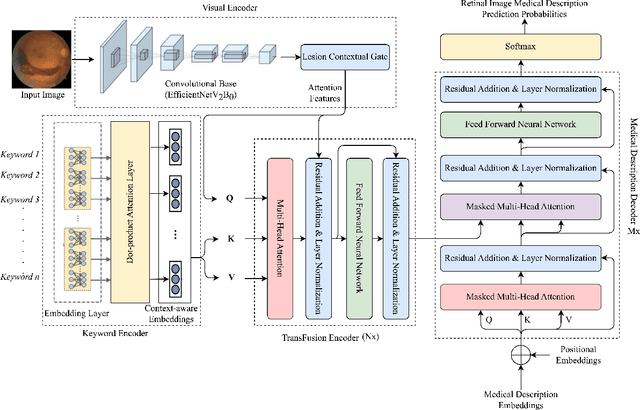


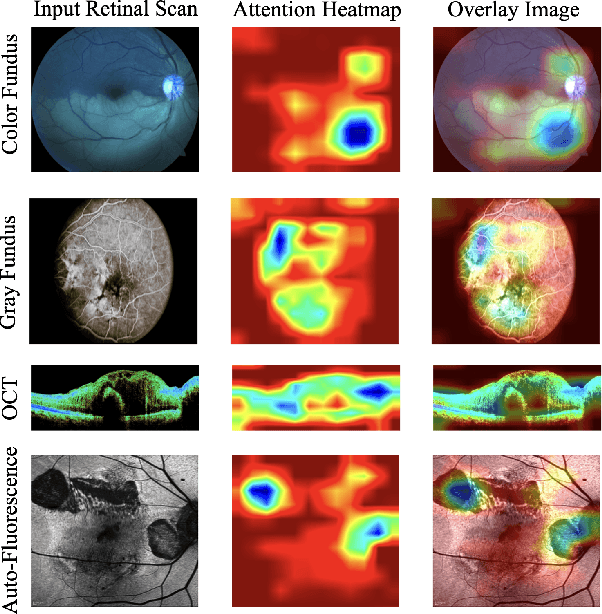
Abstract:Automated retinal image medical description generation is crucial for streamlining medical diagnosis and treatment planning. Existing challenges include the reliance on learned retinal image representations, difficulties in handling multiple imaging modalities, and the lack of clinical context in visual representations. Addressing these issues, we propose the Multi-Modal Medical Transformer (M3T), a novel deep learning architecture that integrates visual representations with diagnostic keywords. Unlike previous studies focusing on specific aspects, our approach efficiently learns contextual information and semantics from both modalities, enabling the generation of precise and coherent medical descriptions for retinal images. Experimental studies on the DeepEyeNet dataset validate the success of M3T in meeting ophthalmologists' standards, demonstrating a substantial 13.5% improvement in BLEU@4 over the best-performing baseline model.
Spatial Sequence Attention Network for Schizophrenia Classification from Structural Brain MR Images
Jun 18, 2024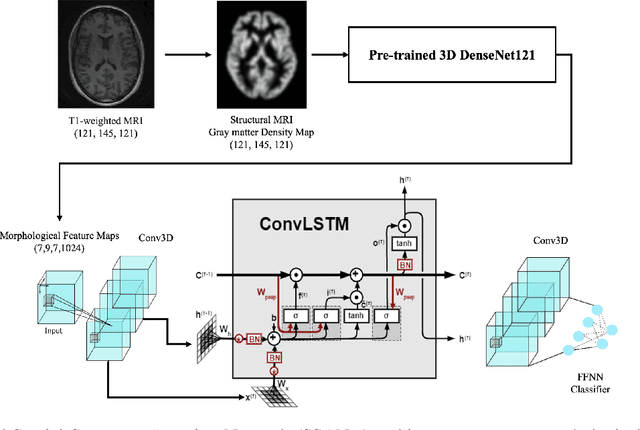
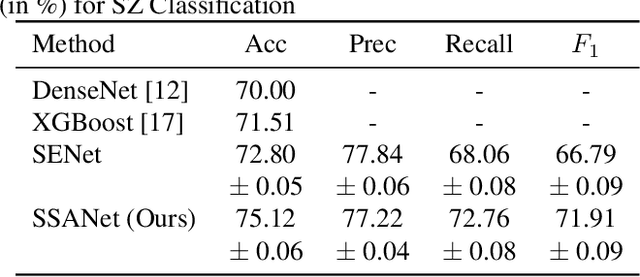
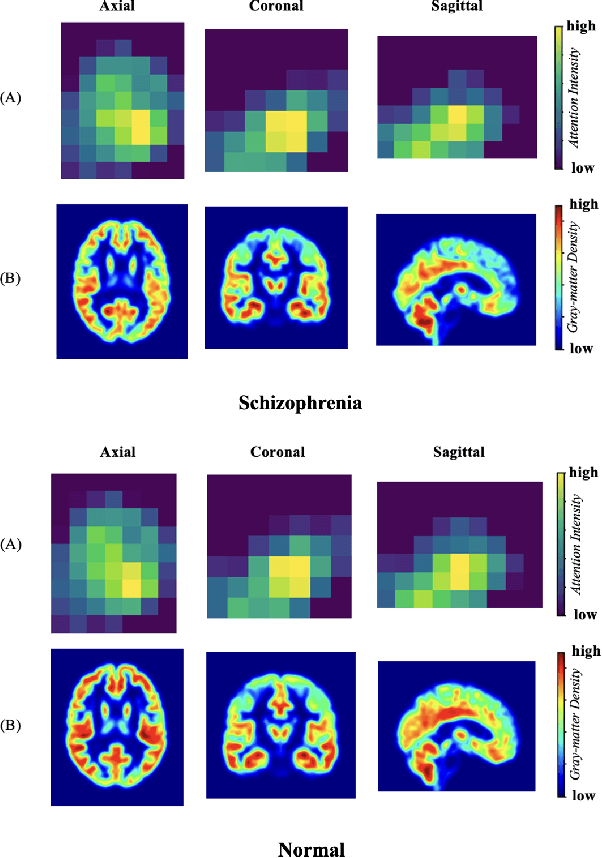
Abstract:Schizophrenia is a debilitating, chronic mental disorder that significantly impacts an individual's cognitive abilities, behavior, and social interactions. It is characterized by subtle morphological changes in the brain, particularly in the gray matter. These changes are often imperceptible through manual observation, demanding an automated approach to diagnosis. This study introduces a deep learning methodology for the classification of individuals with Schizophrenia. We achieve this by implementing a diversified attention mechanism known as Spatial Sequence Attention (SSA) which is designed to extract and emphasize significant feature representations from structural MRI (sMRI). Initially, we employ the transfer learning paradigm by leveraging pre-trained DenseNet to extract initial feature maps from the final convolutional block which contains morphological alterations associated with Schizophrenia. These features are further processed by the proposed SSA to capture and emphasize intricate spatial interactions and relationships across volumes within the brain. Our experimental studies conducted on a clinical dataset have revealed that the proposed attention mechanism outperforms the existing Squeeze & Excitation Network for Schizophrenia classification.
 Add to Chrome
Add to Chrome Add to Firefox
Add to Firefox Add to Edge
Add to Edge